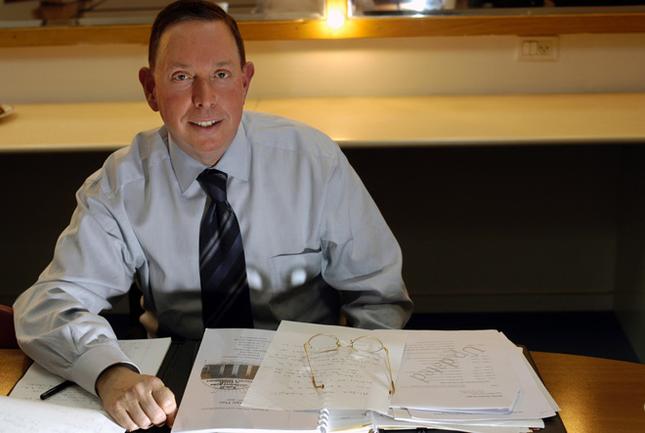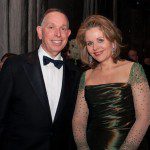The Kennedy Center’s Change Agent, Michael Kaiser
By • September 12, 2013 0 2520

For Michael Kaiser, this is a time of change.
He is in the home stretch of his long—and very successful—tenure as president of the Kennedy Center, a job he’s held since January 2001. His tenure has seen major changes and growth for what is, basically, the nation’s cultural center.
In an interview with the Georgetowner in his office, Kaiser, while in the midst of a per-usual hectic schedule of meetings and travel, waxed a little reflective about his work and about the future—along with his and the center’s and cultural institutions in general. It is a subject about which he has written often, spoken constantly in all 50 states and all over the world. There’s a legacy feeling to the conversation, sitting at a long table with Kaiser. (His latest book on the subject of arts management has just been released, “The Cycle,” written with Brett E. Egan.)
“It’s an odd feeling, sure,” Kaiser said. “I know that this will, in effect, be my last full season as president here, and I know that’s final. But I’ve been thinking about this for a long time in any case. I actually meant to do it sooner, but when we worked out this affiliation with the Washington National Opera in 2011, I felt I had to stay on to see the process through, and it’s been a gratifying thing to do. Once that was done, I knew I would not continue. This is, by far, the longest I’ve ever held a single job. So, In my mind, I think it was the right time. There is always room and a need for fresh thought, fresh vision, even different tastes.”
“I do feel at times a certain sadness,” he added. “I’ve been very lucky to work with tremendously hard-working, gifted colleagues and board members.” Kaiser has also been blessed with the presence of Kennedy Center Chairman of the Board David Rubenstein, a very active, philanthropic-minded, hands-on and generous chair.
It’s not like Kaiser is leaving next week—his contract is not up until December 2014—and it’s not like he’s doing a disappearing act. He remains at the center as head of his own creation, the Kennedy Center Arts Management Institute, now called the DeVos Institute of Arts Management. It’s named after Dick and Betsy DeVos, who made a $22.5-million commitment to the institute, which provides advanced training for arts administrators and has advised individuals, organizations, foundations and governments.
Kaiser has been more than keen on the subject of how to run cultural organizations of all sizes, from the big (the Kennedy Center) to the small theater, still looking for a home. He has travelled, written books and held classes and symposiums on the subject. “There is a climate for the past few years now, ever since the [economic] crash that the arts are in a state of financial crisis,” he said. “To a real extent, that’s been true, but the answer from many groups has been to cut spending, to institute layoffs, to produce unadventurous, safe works. I think that approach is suicidal. I think you need to take care of your audiences, to put butts in the seats, as you always hear, and that’s certainly true, but you can’t abandon innovation, you haves to pursue it, to embrace it. You have to be smart in your choices. You don’t weaken your institution with short-term solutions.”
You wonder, of course, where he finds the time, not just to think, but to be a kind of John the Baptist for smart arts management and to be able to practice it at the same time.
“I don’t have very many days off,” Kaiser said. “I love the work, it’s who I am.” The suspicion exists that he doesn’t like to take days off.
Kaiser came to the Kennedy Center with a reputation as a turn-around artist, a game changer, having done just that when working with the Alvin Ailey Dance American Dance Theatre, the American Ballet Theatre and the Royal Opera House in London. He served as executive director for all three institutions.
“The Kennedy Center, when I came here, wasn’t in trouble.” he said. “But, in some quarters, it was considered to be somewhat staid and predictable in its programming. That it was not very exciting.”
That’s one thing that changed with Kaiser over the years, almost right at the start. “In terms of theater, it seemed mostly centered around road shows,” he said. “Creating productions from the ground up at the Kennedy Center—that’s what I wanted to do.”
And he did, right off the bat, with “The Sondheim Celebration,” a series of top-drawer productions of Stephen Sondheim musicals from “Company” and “Passion” to “A Little Night Music” and “Sweeney Todd,” orchestral programs, discussions and a marketing campaign that gained national attention, making the festival both a huge success and a harbinger of things to come.
“I had wanted to do something like that for a very long time, and I was prepared to go,” he said. The festival was the first of many festivals: ten plays by August Wilson, fully produced or with readings in chronological order, the Tennessee Williams Festival, which included a critically acclaimed “The Glass Menagerie” and a Michael Kahn-directed program of short plays.
There was also the phenomenal nearly half a year Shakespeare Festival, in numerous venues throughout the city co-directed with Kahn, the artistic director of the Shakespeare Theatre Company, a festival that was kicked off with an electric-staged and free reading of “Twelfth Night,” which filled the Kennedy Center’s Concert Hall.
That was a vivid illustration of the Kaiser belief that the Kennedy Center must be not only the nation’s cultural center but a vital, participating member of the Washington cultural and arts community. “We must be a part of the community and bring the community here, make it accessible, engage the community and become engaged with it,” he said.
Under Kaiser, the Kennedy Center has expanded its education programs and outreach. It has mounted the annual Page-to-Stage Festival, which includes many of the area’s theater companies, while the Woolly Mammoth Theater, Synetic Theater and the Washington Ballet have performed at various times on the center’s stages.
Kaiser has also expanded the center’s ground-up theatrical productions, offering ground-up, expensive re-imaginings and re-stagings of “Ragtime” and Stephen Sondheim’s “Follies,” both of them going to Broadway.
“Follies” was another illustration of using local artists—some of the actors cast were local, and Eric Schaeffer, the artistic director and founder of Signature Theatre in Arlington, directed the production and also was a artist participant in the Sondheim Festival. It was a singular act of original work and collaboration.
Kaiser sounded particularly proud of the two productions as well as the initially puzzling decision to stage “The Guardsman,” a somewhat obscure vehicle from the past, which turned out to be a dazzling production and play about theater and theater people this past season.
“Not everything works, but I’m sure that was a head-scratcher for some people,” he said. “But I had a feeling about that, and sometimes you take risks.”
Kaiser, it’s safe to say, with his books, his demeanor of competence and enthusiasm and confidence, isn’t always thought of as a risk-taker, but sometimes, you suspect there lurks a little bit of a cultural rebel behind the façade. “I believe in innovation,” he said. “I believe in supporting new plays, new choreographers, new music. “
He also knows how to be a magical, highly effective fundraiser: “You have to see your institution—this institution—as a family, which means board members, funding, givers, donors, the audience, and artists, and everyone must be encouraged to be an active member of that family—not just on the sidelines, or consumer, or in the seats, but in all the different ways families function.”
To Kaiser, that family is a big one. His biggest innovation at the Kennedy Center in terms of programming may be the grand festivals of international cultures he’s initiated and put together, often on a scale that might have been difficult to imagine. “I’m proud of that certainly because it exposes us, engages us with other cultures, and other institutions struggling to produce and create outstanding work. For me, it was especially exciting to go to Africa, or the Middle East, see dance companies and artists and managers and share with them.”
The result has been festivals which brought with them companies, individuals, artists, dancers, actors, singers, operas, and art forms rarely, if ever, seen here before from China, India, the recent “Nordic Cool,” Africa, Japan and perhaps, most significantly, the 22 countries of the Arab World. It’s hard to measure, of course, how the individual components of each festival were received or attended. Overall, each brought something new to this most international of cities in America.
If there is a theme to be garnered from Kaiser when it comes to cultural institutions, it may be three words: local, national and global—and the connections those three words imply.
In person, Kaiser almost always seems affable, but it’s the kind of affability that is also dead serious about the arts, about his work and legacy. He hasn’t escaped criticism or controversy, but he’s also been a risk-taker and a futurist, looking ahead—because life is change and Kaiser wants to be ahead of the curve while leaving behind a legacy that is sturdy, solid and memorable.
Change comes to us all, and so Kaiser embarks on his last full season. In the meantime, he’s taking another major, life-changing step Aug. 31 when he marries John Roberts, an economist with the U.S. Commodity Futures Trading Commission in the upstairs atrium at the Kennedy Center.
- Michael M Kaiser | Ilan Mizrahi



